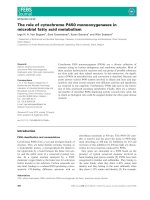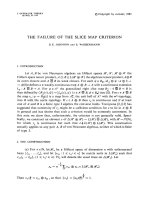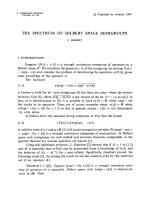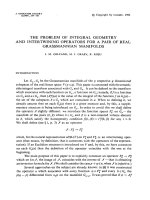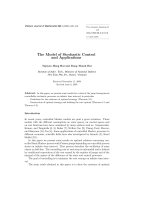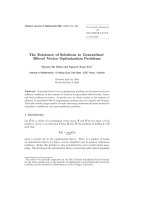Báo cáo toán học: "The Number of Solutions of X 2 = 0 in Triangular Matrices Over GF" pdf
Bạn đang xem bản rút gọn của tài liệu. Xem và tải ngay bản đầy đủ của tài liệu tại đây (85.91 KB, 2 trang )
The Number of Solutions of X
2
=0in Triangular Matrices Over GF(q)
Shalosh B. EKHAD
1
and Doron ZEILBERGER
1
Abstract: We prove an explicit formula for the number of n × n upper triangular matrices, over
GF(q), whose square is the zero matrix. This formula was recently conjectured by Sasha Kirillov
and Anna Melnikov [KM].
Theorem. The number of n × n upper-triangular matrices over GF(q) (the finite field with q
elements), whose square is the zero matrix, is given by the polynomial C
n
(q), where,
C
2n
(q)=
j
2n
n − 3j
−
2n
n − 3j − 1
· q
n
2
−3j
2
−j
,
C
2n+1
(q)=
j
2n +1
n − 3j
−
2n +1
n − 3j − 1
· q
n
2
+n−3j
2
−2j
.
Proof. In [K] it was shown that the quantity of interest is given by the polynomial A
n
(q)=
r≥0
A
r
n
(q), where the polynomials A
r
n
(q) are defined recursively by
A
r+1
n+1
(q)=q
r+1
· A
r+1
n
(q)+(q
n−r
− q
r
) · A
r
n
(q); A
0
n+1
(q)=1. (Sasha)
For any Laurent formal power series P(w), let CT
w
P(w) denote the coefficient of w
0
. Recall that
the q-binomial coefficients are defined by
m
n
q
:=
(1 − q
m
)(1 − q
m−1
) ···(1 − q
m−n+1
)
(1 − q)(1 − q
2
) ···(1 − q
n
)
, (Carl)
whenever 0 ≤ n ≤ m,and0otherwise.
Lemma 1. We h ave
A
r
n
(q)=CT
w
(1 − w)(1 + w)
n
q
r(n−r)
w
r
∞
i=0
(−1)
i
q
−(i+1)i/2−i(n−2r)
i + n − 2r
i
q
w
i
. (Anna)
Proof. Call the right side of Eq. (Anna), S
r
n
(q). Since S
0
n+1
(q) = 1, the lemma would follow by
induction if we could show that
S
r+1
n+1
(q) − q
r+1
· S
r+1
n
(q) − (q
n−r
− q
r
) · S
r
n
(q)=0. (Sasha
)
1
Department of Mathematics, Temple University, Philadelphia, PA 19122, USA. [ekhad,zeilberg]@math.temple.edu,
zeilberg] .
Supported in part by the NSF. Nov. 28, 1995.
1
Using the linearity of CT
w
, manipulating the series, using the definition (Carl)oftheq−binomial
coefficients, and simplifying, brings the left side of (Sasha
)tobeCT
w
Φ
r
n
(q, w), where Φ
r
n
is zero
except when n is odd and r =(n − 1)/2, in which case it is a monomial in q times
(1−w)(1+w)
n
w
r+1
,
and applying CT
w
kills it all the same, thanks to the symmetry of the Chu-Pascal triangle.
Summing the expression proved for A
r
n
(q), yields that
A
n
(q)=CT
w
(1 − w)(1 + w)
n
·
∞
r=0
r
i=0
(−1)
i
q
r(n−r)−(i+1)i/2−i(n−2r)
i + n − 2r
n − 2r
q
w
i−r
.
Letting l = r − i, and changing the order of summation, yields
A
n
(q)=CT
w
(1 − w)(1 + w)
n
·
n/2
=0
w
−
· q
n−
2
(n−2)/2
i=0
(−1)
i
q
i(i−1)/2
n − 2 − i
i
q
.
(SumAnna)
Luckily, the inner sum evaluates nicely thanks to the following.
Lemma 2. We h ave
m/2
i=0
(−1)
i
q
i(i−1)/2
m − i
i
q
=(−1)
m/3
q
m(m−1)/6
· χ(m ≡ 2mod3),
where χ(···) is the truth value (=1 or 0) of the proposition “···”.
Proof. While this is unlikely to be new
2
, it is also irrelevant whether or not it is new, since such
things are now routine, thanks to the package qEKHAD, accompanying [PWZ]. Let’s call the left
side divided by q
m(m−1)/6
, Z(m). Then we have to prove that Z
0
(m):=Z(3m)equals(−1)
m
,
Z
1
(m):=Z(3m +1) equals(−1)
m
,andZ
2
(m):=Z(3m + 2) equals 0. It is directly verified that
these are true for m =0, 1, and the general result follows from the second order recurrences produced
by qEKHAD. The input files inZ0, inZ1, inZ2 as well as the corresponding output files, outZ0, outZ1,
outZ2 can be obtained by anonymous ftp to ftp.math.temple.edu, directory pub/ekhad/sasha.
The package qEKHAD can be downloaded from />To complete the proof of the theorem, we use lemma 2 to evaluate the inner sum of (SumAnna),
then to get A
2n
(q), we replace n by 2n, and then replace l by l + n, and finally use the binomial
theorem. Similarly for A
2n+1
(q).
References
[K] A.A. Kirillov, On the number of solutions to the equation X
2
=0in triangular matrices
over a finite field, Funct. Anal. and Appl. 29 (1995), no. 1.
[KM] A.A. Kirillov and A. Melnikov, On a remarkable sequence of polynomials,preprint.
[PWZ] M. Petkovˇsek, H.S. Wilf, and D. Zeilberger, “A = B”, A.K.Peters, 1996.
2
For a ‘classical’ proof, see Christian Krattenthaler’s message, at />2
